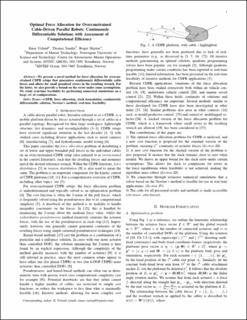| dc.contributor.author | Ueland, Einar Skiftestad | |
| dc.contributor.author | Sauder, Thomas Michel | |
| dc.contributor.author | Skjetne, Roger | |
| dc.date.accessioned | 2022-02-14T09:37:02Z | |
| dc.date.available | 2022-02-14T09:37:02Z | |
| dc.date.created | 2020-10-17T12:51:35Z | |
| dc.date.issued | 2020 | |
| dc.identifier.citation | IEEE Transactions on Robotics. 2020, 37 (2), 659-666. | en_US |
| dc.identifier.issn | 1552-3098 | |
| dc.identifier.uri | https://hdl.handle.net/11250/2978665 | |
| dc.description.abstract | In this article, we present a novel method for force allocation for overconstrained cable-driven parallel robot setups that guarantees continuously differentiable cable forces and allows for small penalized errors in the resulting wrench. For the latter, we also provide a bound on the error under some assumptions. We study real-time feasibility by performing numerical simulations on a large set of configurations. | en_US |
| dc.language.iso | eng | en_US |
| dc.publisher | Institute of Electrical and Electronics Engineers (IEEE) | en_US |
| dc.relation.uri | https://www.sintef.no/en/projects/real-time-hybrid-model-testing/ | |
| dc.subject | Kybernetikk | en_US |
| dc.subject | Cybernetics | en_US |
| dc.subject | Marin kybernetikk | en_US |
| dc.subject | Marine cybernetics | en_US |
| dc.subject | Bevegelsesstyring | en_US |
| dc.subject | Motion control | en_US |
| dc.subject | Kraftallokering | en_US |
| dc.subject | Force allocation | en_US |
| dc.title | Optimal Force Allocation for Overconstrained Cable-Driven Parallel Robots: Continuously Differentiable Solutions With Assessment of Computational Efficiency | en_US |
| dc.type | Peer reviewed | en_US |
| dc.type | Journal article | en_US |
| dc.description.version | acceptedVersion | en_US |
| dc.rights.holder | © IEEE. Personal use of this material is permitted. Permission from IEEE must be obtained for all other uses, in any current or future media, including reprinting/republishing this material for advertising or promotional purposes, creating new collective works, for resale or redistribution to servers or lists, or reuse of any copyrighted component of this work in other works. | en_US |
| dc.subject.nsi | VDP::Annen marin teknologi: 589 | en_US |
| dc.subject.nsi | VDP::Other marine technology: 589 | en_US |
| dc.source.pagenumber | 659-666 | en_US |
| dc.source.volume | 37 | en_US |
| dc.source.journal | IEEE Transactions on Robotics | en_US |
| dc.source.issue | 2 | en_US |
| dc.identifier.doi | 10.1109/TRO.2020.3020747 | |
| dc.identifier.cristin | 1840301 | |
| dc.relation.project | Norges forskningsråd: 223254 | en_US |
| dc.relation.project | Norges forskningsråd: 254845 | en_US |
| cristin.ispublished | true | |
| cristin.fulltext | postprint | |
| cristin.fulltext | postprint | |
| cristin.qualitycode | 2 | |
